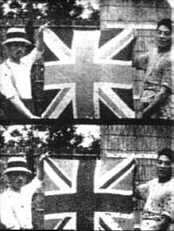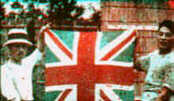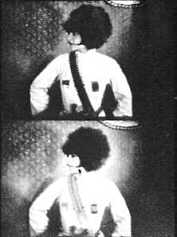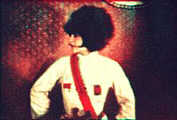

Kinemacolor Descendants Lots of pictures on this page so be patient. The processes shown on this page all share similar characteristics. They were two-color systems using either red/green filtration or red-orange/blue-green filtration. They photographed both color records simultaneously and projected them simultaneously, which provided better images than the sequential type which fringed severly when fast moving objects were shown. They also recorded their two color records within the area of a conventional 35mm frame, resulting in low resolution when projected to normal screen dimensions.

The color records above are red in the top frame and green in the lower frame.

The choice of subject matter for this film is interesting in that the Union
Jack contains both blue and pure white colors, neither of which could be
accurately recorded in any two-color process. Inasmuch as this is the flag
of The United Kingdom, we should refer to this film as being two-colour.
Raycol (Circa 1928-1933)
The frames are: Top - red/orange Bottom - blue/green.
While the title and subject matter of this film are unknown, one gets the impression that this gentleman has a pint of some refreshment nearby.
Busch System
(Circa 1930)The various additive 2-color systems utilized such similar technology that sometimes extremes were gone to in order to be able to obtain patents. The Busch system utilized a camera that ran its film horizontally and the two images were recorded in the area occupied by a single normal frame, with the green image on top and the red image at the bottom. At this point we have not found information on the design of the projector. The camera is illustrated below.


Left: The frames are: Top - green Bottom - red. Here, too, the title and subject matter are unknown. The young woman is either dressed as a very pretty Cossack, or is a clairvoyant wearing an Elizabeth Taylor wig and a Michael Jackson coat. In any case, it is always refreshing to see a beautiful woman, and that's what we assume this poor reproduction to be.
Another example of the Busch system.
Left: The Busch system camera. While the body of the camera was quite compact, the threading arrangement looks as though jams and buckled film could have been a problem. The front of the camera is flipped up showing the two apertures. Mounted to the front of the camera, in the large cylinder, is the camera lens and prism arrangement required to split the image into its red and green elements. Seen above the apertures is what appears to be an optical viewfinder. This does not look like a camera that would be easy to load.
Camera and multiframe negative photos courtesy of Jan-Eric Nyström
Cosmocolor
(1935 - System 1 - Additive and System 2 - Subtractive)This system appears to be an out and out duplicate of the Busch System. The process began as a two-color additive scheme invented in 1935 by Otto C. Gilmore. It was converted to a subtractive process before it was ever used to make a feature film. We have no details of how the subtractive prints were made. As seen in this illustration, the two-color process seems to be identical to Busch.
Frame 1 is the red record and Frame 2 is the green record.It is reported that the only feature picture made in the Cosmocolor two-color subtractive process was RKO's The Isle of Destiny released in 1940.
(System 3 - Three Color Subtractive - 1943)
This variation placed all three color records within the confines of a conventional four perforation frame, with two colors occupying the left half of the frame and the third, rotated 90 degrees, placed in the other half. No feature films are known to have been made in this process, nor are there any details of the method planned for making full frame three color prints.
Cosmocolor information courtesy of John Whittle
Color images created at The American WideScreen Museum and Film Technology Center,
Houston, Texas, U.S.A. ©1996, 1998
Back to Additive Color Film Processes
Return to Start Page
©1997-1998 The American WideScreen Museum